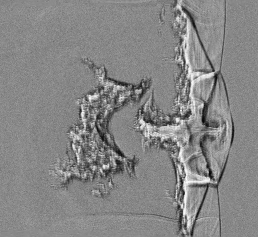Detonation waves in gases have a three-dimensional reaction zone structure. Their structure departs from the laminar, one-dimensional reaction zone structure postulated by Zel’dovich, Von Neumann and Doering. We review our recent experiments that established how the detonation cellular structure enhances the detonability of detonations.
Three main mechanisms were established. The first mechanism is the reflection of triple points, which amplifies the lead shock by shock focusing. The stronger shock leads to higher temperatures and faster rate of energy release. For a sufficiently rapid energy release rate, frontal and transverse detonation waves are created with embedded sonic surfaces.
The second mechanism involves the convection assisted ignition by forward jets. When the lead shock ignition becomes inefficient, remaining hotspots created by triple shock reflection are convected by jets. The origin of the jets is the triple shock reflections. The third mechanism is the deflagrative burning along layers where hydrodynamic instabilities are created. This mechanism burns out large portions of non-reacted pockets, which have escaped ignition by the first two mechanisms. Parameters controlling each mechanism are reviewed and ongoing modeling approaches are discussed.
1 Avenue Clément Ader
salle B266/B267
85360 Chasseneuil du Poitou

